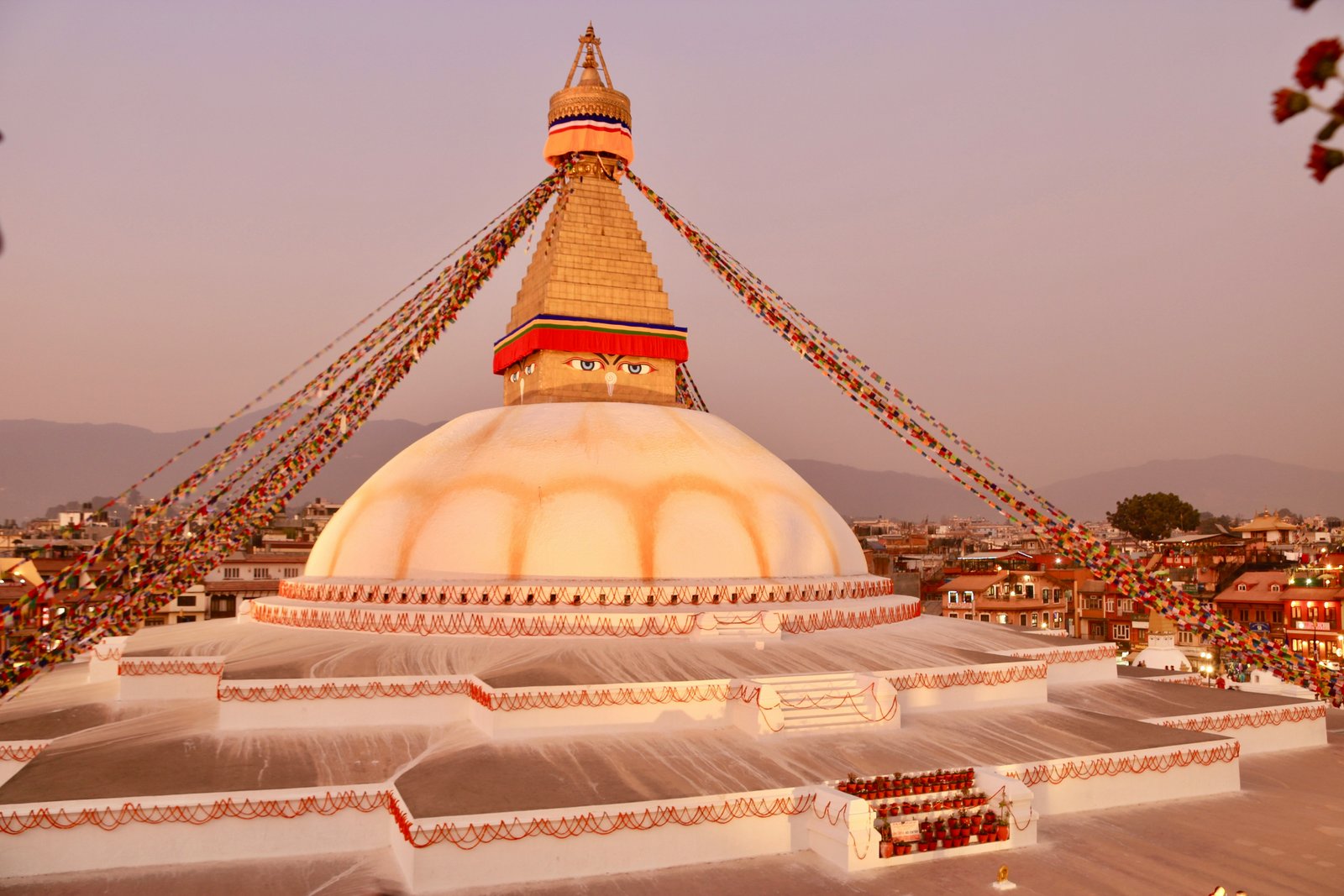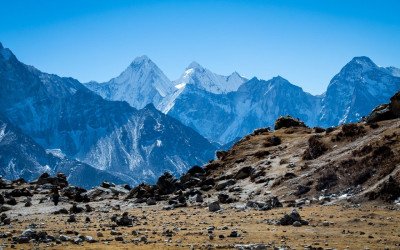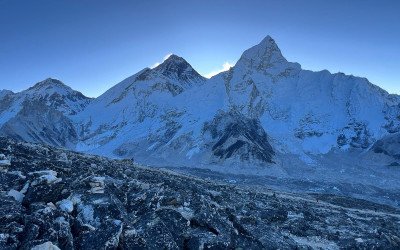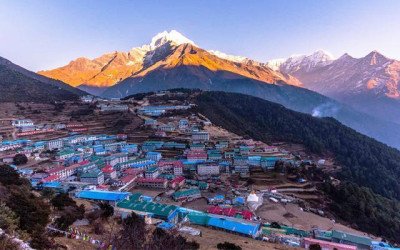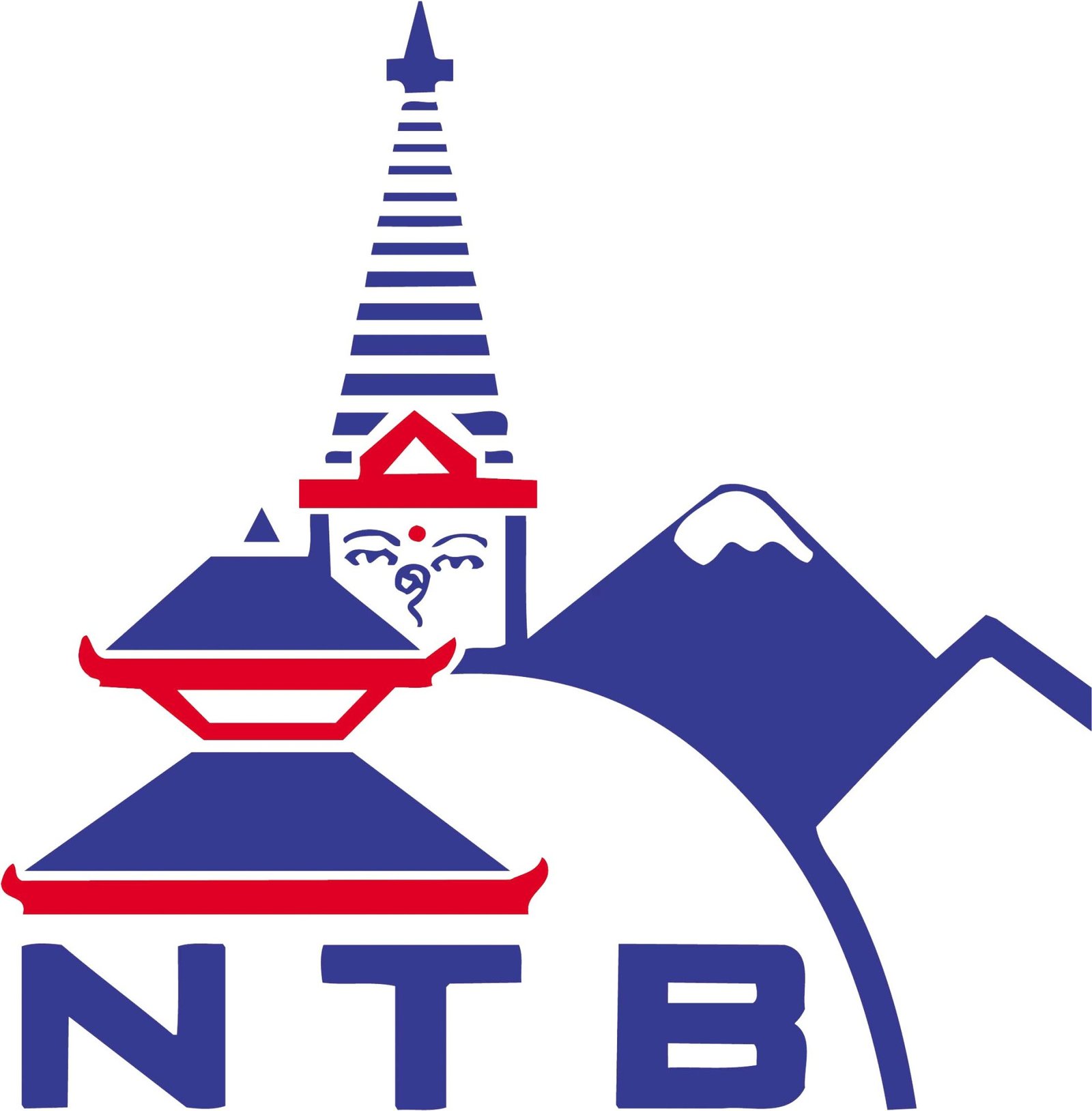- Registered Company
- More than Decade of Experience
- Customer Satisfaction is our motto
Outline Itinerary
Day 1: Flight from Kathmandu (1400m) to Lukla (2840m) and Trek to Phakding (2610m)
Day 2: Trek from Phakding (2610m) to Namche Bazaar (3440m)
Day 3: Acclimatization and Rest Day in Namche Bazaar (3440m)
Day 4: Trek from Namche Bazaar (3440m) to Tengboche (3810m)
Day 5: Trek from Tengboche (3810m) to Dingboche (4410m)
Day 6: Acclimatization Day in Dingboche (4410m)
Day 7: Trek from Dingboche (4410m) to Lobuche (4910m)
Day 8: Trek from Lobuche (4910m) to Gorakshep (5140m), then Everest Base Camp (5364m), and back to Gorakshep (5140m)
Day 9: Gorakshep (5140m) to Kalapatthar (5545m), then descend to Pangboche (3930m)
Day 10: Trek from Pangboche (3930m) to Monjo (2835m)
Day 11: Trek from Monjo (2835m) to Lukla (2840m)
Day 12: Flight from Lukla (2840m) to Kathmandu (1400m)
Altitude Map
This Altitude Map shows highest alttitude you will trek to each day.
Group Cost
| Group | Cost |
|---|---|
| 1-1 pax | $1400 |
| 2-4 pax | $1200 |
| 5-8 pax | $1100 |
| 9-15 pax | $1050 |
Package Included
- Necessary local transport by private vehicle.
- Accommodation in Kathmandu at 3-star standard hotels with breakfast included.
- Guided sightseeing in Kathmandu with an experienced tour guide.
- Entrance fees for all sightseeing spots in Kathmandu and National Park fees during treks.
- Accommodation in lodges/guesthouses during the trekking days.
- Meals are provided on a full-board basis (breakfast, lunch, and dinner) during trekking, including tea/coffee.
- Experienced, government-licensed trek guide and porter to carry luggage.
- Insurance coverage for our field staff.
- Permits are required for trekking and group medical supplies (first aid kit).
- Lukla-Kathmandu flight ticket with baggage allowance (up to 15kg).
- All additional government taxes.
Package not Includes
- Nepal entry visa fee.
- International airfare to and from Kathmandu.
- Compulsory traveler's insurance.
- Alcoholic and non-alcoholic drinks during the trek.
- Lunch and dinner in Kathmandu.
- Any additional expenses incurred due to unexpected events such as flight cancellations, personal illness, strikes, or political disturbances.
Trip Overview
The Budget Everest Base Camp Trek is an opportunity to see one of the most beautiful trekking areas at a lower cost.
The main point of beginning in the Everest region is Lukla, which trekkers reach flying from Nepal's colorful capital, Kathmandu. From there, the trail passes through beautiful Sherpa villages and dense forests and then crosses rough mountain terrain.
En route, the trekkers also encounter popular stopover points, including Namche Bazaar, considered the economic capital of the Khumbu area, and Tengboche Monastery, which offers an amazing panorama of the surroundings. The trek finishes at Everest Base Camp.
The essence of the Budget Everest Base Camp Trek guarantees a beautiful and memorable trek in the mountains, an entire meeting with interesting people, views of fascinating nature, and the excitement of having an achievement. The trek is one of a kind, and it is easy to moderate to ensure that all tourists with limited budgets can undertake the trek at a keystone cost.
Overnight stays require 8-10 hour treks, and for this, clients spend their time in teahouses, which offer simple but satisfactory food and a place to stay. These teahouses consist of rooms that local families own, so trekkers experience the authentic Sherpa culture and warmth.
Trekking is done daily, depending on the itinerary, to avoid having to rush or being too relaxed, increasing the chances of suffering from altitude sickness. This is also beautiful and colourful, varying from thick rhododendron forests to sheer cliffs and boulder-strewn slopes.
The high points of a Budget Everest Base Camp Trek are the two days spent at the Everest Base Camp and on the Kala Patthar, which gives magnificent close-up views of the Everest massif and other mountains.
Although the basics of the Budget Everest Base Camp Trek are cheap and the best deal, they do not compromise safety and comfort. Trekkers are provided with guides and porters to avoid any trouble while on the Budget Everest Base Camp Trek. Knowledgeable guides are the key to every trek and enlighten the tourists with stories about the area's history, culture, and geography.
It is relatively easy to moderate and good for experienced hikers and new trekkers. This is possible if one prepares adequately, and in terms of fitness, it is a trip available for anyone. The Budget Everest Base Camp Trek is one of the best treks for those wishing to have a splendid journey through the Himalayas but are constrained by the hefty prices that this experience typically comes with.
One can also choose Luxury Everest Base Camp Trek if they have a high budget and want to experience luxury.
Highlights of Budget Everest Base Camp Trek – Trekking Made Affordable
- Scenic flight from Kathmandu to Lukla
- Trek through picturesque Sherpa villages
- Stunning views of Mount Everest and surrounding peaks
- Crossing iconic suspension bridges
- Exploring Namche Bazaar and its vibrant market
- Visiting ancient monasteries and cultural landmarks
- Trekking through lush rhododendron and pine forests
- Experiencing the unique Sherpa culture and hospitality
Detail Itinerary
Flight from Kathmandu (1400m) to Lukla (2840m) and Trek to Phakding (2610m)
You begin the Budget Everest Base Camp Trek with a flight from Kathmandu to Lukla. The flight lasts 30-40 minutes and ends with a scenic view of the Himalayan foothills and areas around. Taking off and landing at Lukla is even more thrilling. It is probably one of the most daring airstrips globally, with a steep and short slope.
On reaching Lukla, you will be greeted by your trekking crew, and then you start your trek to Phakding. The actual hike is a round trip of about 8 km and usually lasts 3 to 4 hours. The trail passes through some stunning forest cover and small Sherpa settlements and over the occasional sight of the mountains.
You must also continue crossing several suspension bridges over the Dudh Koshi River. This is Phakding village, at an altitude of 2610 meters. You will spend the night in one of the basic teahouses to experience the hospitality of the Sherpas and prepare for the upcoming days.
Breakfast, Lunch and Dinner
Lodge/Hotel
2610m

Trek from Phakding (2610m) to Namche Bazaar (3440m)
Namche Bazaar, an exciting place we will visit today, is one of the most striking villages in the Everest region. The journey is approximately 11 km or 7 miles, and it usually takes 6-7 hours.
The trek coincides with the Dudh Koshi River, and one has to cross several suspension bridges, one of which is the Hillary Bridge, one of the most famous. You ascend through vast areas of pine and rhododendrons with an occasional look up at the mountains.
Namche Bazaar is situated a bit higher in comparison with other places, so when approaching this village, you will need to climb a rather steep hill. Namche, the main Sherpa village at 3440m, is famous for its shops, streets, and impressive view of Everest, Lhotse and other mountains.
This is a significant acclimatization point where one can have a look at the different shops, cafes and other places of interest within the town.
Breakfast, Lunch and Dinner
Lodge/Hotel
3440m
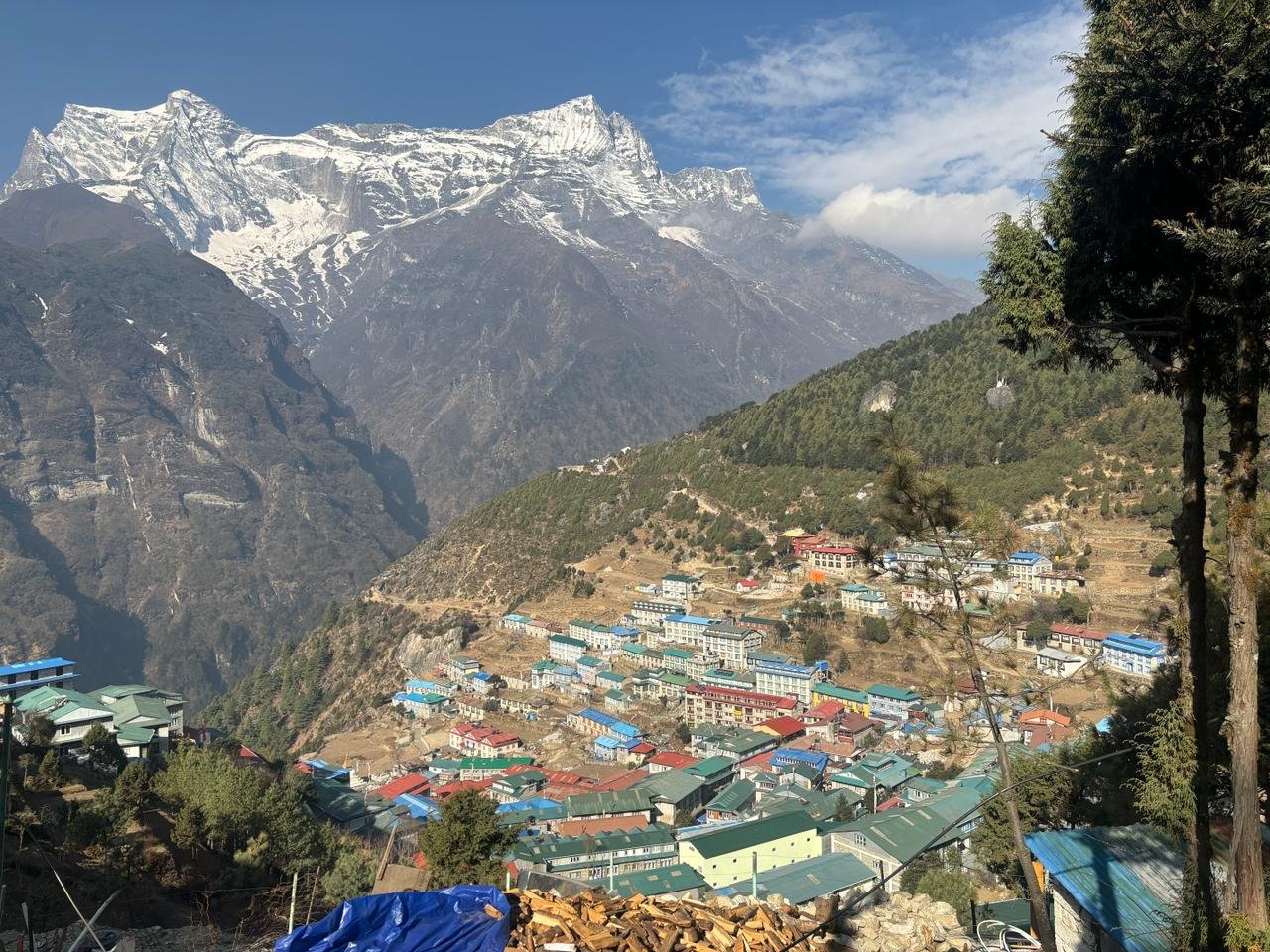
Acclimatization and Rest Day in Namche Bazaar (3440m)
Today, we have another day of walking—from Namche Bazaar to Tengboche, which will be approximately 10 km (6 miles) and will take about 5-6 hours. Initially, from the viewpoint, the trail moves downward through the extensive forest, crosses the Dudh Koshi River, and then gradually ascends for some hours through the beautiful landscape.
The route is excellent technically, and the panoramas are stunning, especially considering the magnificent mountain views of Everest, Island Peak, Lhotse, and Ama Dablam.
On the way to the village, you will pass several small settlements and terraced fields. Tengboche is also famous for the monastery, which is one of the largest monasteries in the Everest area.
Once you have registered with the teahouse, you will be free to tour the monastery and attend a prayer session with locals. This will allow you to experience the place's deeply rooted Buddhist religious culture.
Breakfast, Lunch and Dinner
Lodge/Hotel
3440m

Trek from Namche Bazaar (3440m) to Tengboche (3810m)
On the 5th day, the destination will be Dingboche, and to get there, you will be walking for about 5-6 hours, about 11 km (7 miles) from Tengboche. This Budget Everest Base Camp Trek is characterized by a slow ascent along mountain slopes that are covered with alpine pastures together with small villages. You will also trek along the Imja Khola River and steep up moraines to Island Peak and Lhotse. Dingboche, which is at 4410m, is one of the most famous treks, not only because of the perfect blue skies and tremendous views of the mountains. There are fewer tourists than at Namche Bazaar, and the atmosphere is much more tranquil, which is helpful when acclimatizing and preparing for the days ahead.
Breakfast, Lunch and Dinner
Lodge/Hotel

Trek from Tengboche (3810m) to Dingboche (4410m)
On day 5, you will hike from Tengboche to Dingboche, which is approximately 11 km (7 miles) and will take 5-6 hours. It is an easy walk with a gradual ascent, passing through grasslands and a few villages along the way.
You will see the Imja Khola River and climb through hostile lanes to be rewarded with views of Island Peak and Lhotse, among others. Dingboche, at 4410 meters, is famous for the clarity of the sky and the fantastic view of mountains.
It is less crowded than Namche Bazaar, offering a less bustling environment where travellers can rest before they proceed with the challenging high-altitude treks.
Breakfast, Lunch and Dinner
Lodge/Hotel
4410m
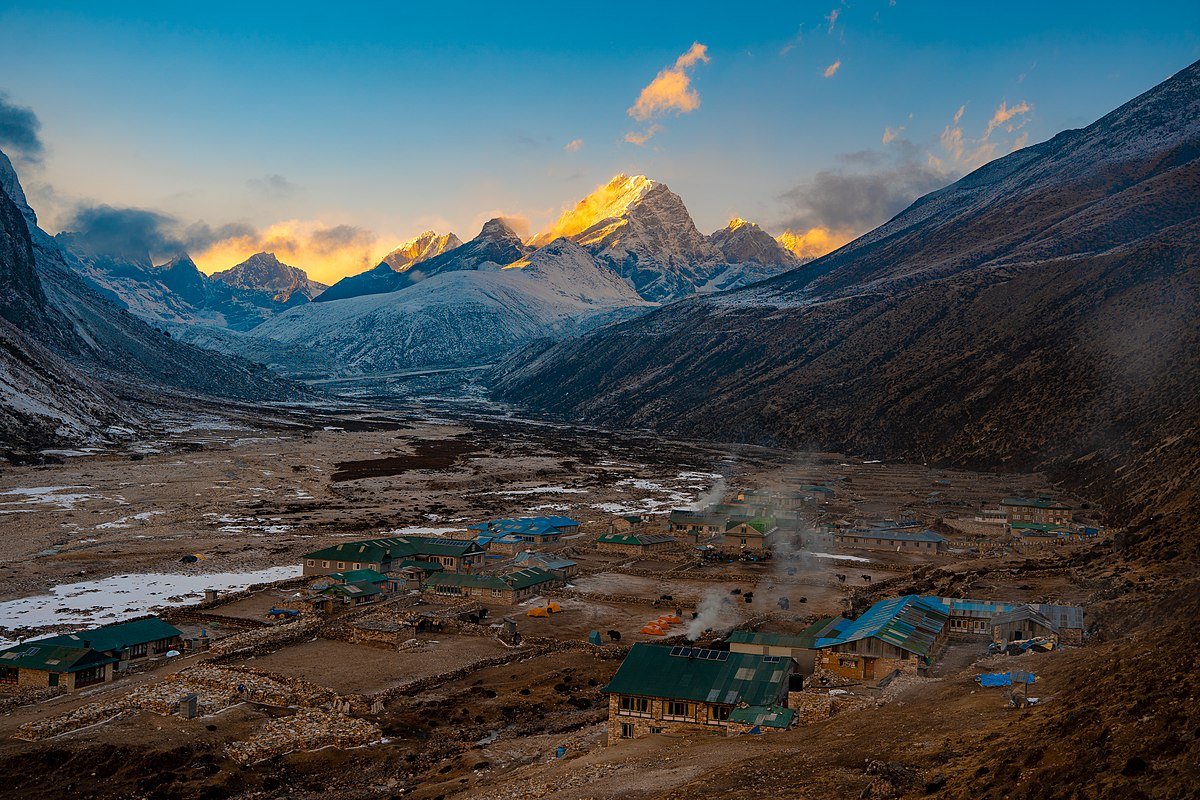
Acclimatization Day in Dingboche (4410m)
This day is for rest to enable the body to adjust to the higher altitude of Dingboche, which is higher than that of Namche Bazaar. Some of the things that one can do would include short nature walks within the area, such as a hike up to the Nangkartshang Peak, which provides vantage views of the mountains and valleys.
This helps to minimize cases of climate sickness at higher altitudes and gets you ready for higher elevations. It also involves taking some time to rest and drink so that the body is fully prepared for the next couple of days. There are also opportunities to walk around and get in touch with nature and the locals, which should help to understand the region's uniqueness.
Breakfast, Lunch and Dinner
Lodge/Hotel
4410m
Trek from Dingboche (4410m) to Lobuche (4910m)
Day 7: Trek from Dingboche (4410m) to Lobuche (4910m)
The seventh day entails hiking from Dingboche to Lobuche, a distance of approximately 5 miles, which takes about 5 to 6 hours. It is relatively less steep and initially progresses over rocky land, with good visibility at the Nuptse and Pumori peaks. You will find yourself crossing shrines to the climbers who have died in the region of Mount Everest. Lobuche, located at 4910 meters, is a small village where you will spend a night in a teahouse. This is probably one of the last significant halts before reaching the base of Mount Everest, which enables one to prepare and adapt to the conditions accordingly.
Breakfast, Lunch and Dinner
Lodge/Hotel
4910m
Trek from Lobuche (4910m) to Gorakshep (5140m), then Everest Base Camp (5364m), and back to Gorakshep (5140m)
This is one of the most challenging and best trek days en route to Kala Pattar and Lobuche. You will wake up early in the morning to hike from Lobuche to Gorekshep; it will take you approximately 3 hrs. Gorakshep to Everest Base Camp will take 2 to 3 hours after lunch and a little break at Gorakshep. The trail is dirty and steep in most areas, and this is accompanied by snow or ice at times; however, the views of the mountains, especially Everest, are beautiful. At Base Camp, you will be able to relax and familiarize yourself with the surrounding views and scenery. You will then return to Gorakshep for lunch and, later in the evening, spend the night after a very exhausting day.
Breakfast, Lunch and Dinner
Lodge/Hotel
5140m
Gorakshep (5140m) to Kalapatthar (5545m), then descend to Pangboche (3930m)
Today, you must trek to Kalapatthar at dawn to behold the rising sun over Mount Everest again. The problematic trek to Kala Patthar 5545m could take 2 to 3 hours, and the best view of Everest's Himalayan peak and other mountains can be seen from this point. Following this, and after breakfast in Gorakshep, you will have to trek for 6 to 7 hours to the village of Pangboche.
The descent is probably easier and will take less time, as you will go through picturesque terrains and utterly archaic towns. At 3930 meters above sea level, Pangboche is quite a prominent place that can serve as a shelter for trekkers.
Breakfast, Lunch and Dinner
Lodge/Hotel
3930m

Trek from Pangboche (3930m) to Monjo (2835m)
Pangboche to Monjo is the journey you will be taking on Day 10; this will be approximately 12km, which is 7. 5 miles, and will take about 6/7 hours. The trail gradually takes you down through the sub-tropical forests and several small Sherpa villages along the way and the Dudh Koshi River.
Some paths are revisited at a particular time in the hike; however, the journey downwards is slightly less challenging than climbing. Monjo is a small village at an altitude of 2835 meters. Here, you will sleep for the night.
Breakfast, Lunch and Dinner
Lodge/Hotel
2835m
Trek from Monjo (2835m) to Lukla (2840m)
Your final trekking day involves walking from Monjo back to Lukla, a distance of about 7 km (4.5 miles) that takes around 4 to 5 hours. The trail follows the Dudh Koshi River, passing through familiar villages and forested areas.
Once you reach Lukla, you'll have time to celebrate the end of your trek with your crew and enjoy the local atmosphere. You'll spend the night in Lukla, preparing for your return flight to Kathmandu the following day.
Breakfast, Lunch and Dinner
Lodge/Hotel
2840m
Flight from Lukla (2840m) to Kathmandu (1400m)
On the last day of your trek, you'll take an earlier morning flight from Lukla back to Kathmandu. The flight offers spectacular aerial views of the Himalayas as you descend into the bustling capital city.
Upon arrival in Kathmandu, you'll have the rest of the day free to relax, explore the town, or celebrate the completion of your trek with fellow travellers. This is the perfect opportunity to reflect on your adventure and enjoy the vibrant culture of Kathmandu before heading home.
Breakfast, Lunch and Dinner
Lodge/Hotel
1400m
